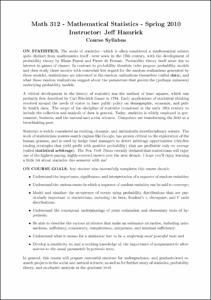Please use this identifier to cite or link to this item:
http://hdl.handle.net/10267/15752Full metadata record
| DC Field | Value | Language |
|---|---|---|
| dc.contributor.author | Hamrick, Jeff | - |
| dc.date.accessioned | 2013-03-05T16:23:15Z | - |
| dc.date.available | 2013-03-05T16:23:15Z | - |
| dc.date.issued | 2010-01-13 | - |
| dc.identifier.uri | http://hdl.handle.net/10267/15752 | - |
| dc.description | This syllabus was submitted to the Office of Academic Affairs by the course instructor. Uploaded by Archives RSA Josephine Hill. | en_US |
| dc.description.abstract | The seeds of statistics—which is often considered a mathematical science quite distinct from mathematics itself—were sown in the 17th century, with the development of probability theory by Blaise Pascal and Pierre de Fermat. Probability theory itself arose due to interest in games of chance. In contrast to probability theorists (who propose probability models and then study those models with somewhat less regard for the random realizations generated by those models), statisticians are interested in the random realizations themselves (called data), and what those random realizations suggest about the parameters that govern the (perhaps unknown) underlying probability models. A critical development in the history of statistics was the method of least squares, which was probably first described by Carl Friedrich Gauss in 1794. Early applications of statistical thinking revolved around the needs of states to base public policy on demographic, economic, and public health data. The scope of the discipline of statistics broadened in the early 19th century to include the collection and analysis of data in general. Today, statistics is widely employed in government, business, and the natural and social sciences. Computers are transforming the field at a breathtaking pace. Statistics is widely considered an exciting, dynamic, and intrinsically interdisciplinary science. The work of statisticians powers search engines like Google, has proven critical to the exploration of the human genome, and is used by hedge fund managers to detect arbitrage opportunities (risk-free trading strategies that yield profit with positive probability) that are profitable only on average (called statistical arbitrage). The New York Times recently declared that statisticians will enjoy one of the highest-paying, highly-coveted careers over the next decade. I hope you’ll enjoy learning a little bit about statistics this semester with me! | en_US |
| dc.language.iso | en_US | en_US |
| dc.publisher | Memphis, Tenn. : Rhodes College | en_US |
| dc.relation.ispartofseries | Syllabi CRN;20297 | - |
| dc.rights | Rhodes College owns the rights to the archival digital objects in this collection. Objects are made available for educational use only and may not be used for any non-educational or commercial purpose. Approved educational uses include private research and scholarship, teaching, and student projects. For additional information please contact archives@rhodes.edu. Fees may apply. | - |
| dc.subject | Syllabus | en_US |
| dc.subject | Curriculum | en_US |
| dc.subject | Academic departments | en_US |
| dc.subject | Text | en_US |
| dc.subject | Mathematics and Computer Science, Department of | en_US |
| dc.subject | 2010 Spring | en_US |
| dc.title | MATH 312-01, Mathematical Statistics, Spring 2010 | en_US |
| dc.type | Syllabus | en_US |
| Appears in Collections: | Course Syllabi | |
Files in This Item:
| File | Description | Size | Format | |
|---|---|---|---|---|
| 2010_SPRING_MATH_312-01_20297.pdf | 42.44 kB | Adobe PDF |  View/Open |
Items in DSpace are protected by copyright, with all rights reserved, unless otherwise indicated.